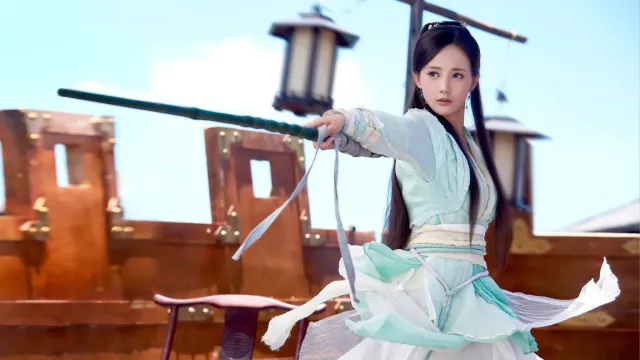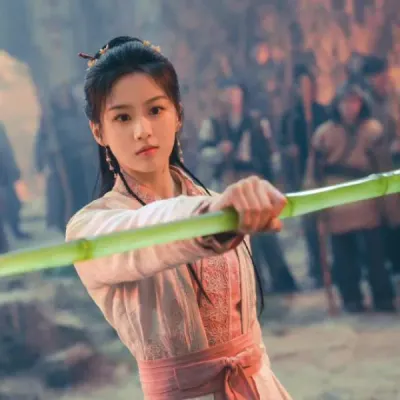The Beggars’ Guild (pinyin: Gàibāng, jyutping: Koi3 Bong1, simplified: 丐帮, traditional: 丐幫) was one of the major martial arts factions in the jianghu. Known as the largest organisation of its time, with over ten million members spread across China, the Guild combined martial prowess with an extensive intelligence network.
Despite its humble origins and name, the faction controlled significant assets and properties, operating as a highly structured society with strict hierarchical rules and a strong code of honor.
Overview
The Guild’s vast influence extended across both banks of the Yangtze River, within and beyond the Shanhai Pass to the east and Jiayu Pass to the west.
Despite being composed primarily of beggars, the faction maintained considerable wealth through various investments and properties.
The Guild was renowned for its role in upholding justice and defending Han Chinese society against foreign invaders.
Politics
The Guild actively assisted the Song Dynasty in its conflicts with foreign powers, particularly during the Jin and Mongol invasions.
They maintained secrecy about their military operations to avoid becoming targets, and played a significant role in defending strategic locations like Xiangyang.
Their intelligence network conducted extensive espionage operations against the Western Xia and other potential threats to the Song Dynasty.
Organisation
The staggering size required a rigidly hierarchical structure to maintain order and effectiveness. The Guild’s organisational model combined elements of military command, bureaucratic administration, and traditional martial arts sectarian structure.
The Guild divided its territory into regional branches, each led by a Branch Master. These branches were named after virtues such as Benevolence, Wisdom, Righteousness, Trust, Propriety, and Courage. Each branch operated with significant autonomy in daily affairs while remaining strictly accountable to the central leadership.
Monthly meetings were held at different locations to maintain coordination between branches and allow the leadership to address Guild-wide issues. These gatherings served as opportunities for information exchange, policy announcements, and resolution of inter-branch disputes.
Succession and leadership
The position of Chief required candidates to demonstrate exceptional martial arts prowess and complete specific trials. New chiefs were required to establish “seven great merits” before receiving the Dog-beating Staff.
The formal succession ceremony included paying respects to the founder’s portrait and accepting the Dog-beating Staff as symbol of authority.
Leadership structure
The Guild maintained a strict hierarchy essential for managing its vast network:
- Chief (帮主 – bāngzhǔ): Supreme leader who carried the Dog-beating Staff as a symbol of authority and held absolute authority, bound by Guild traditions and laws
- Six Great Elders (六大长老 – liù dà zhánglǎo): Highest council under the chief
- Training Elder (传功长老 – chuángōng zhánglǎo): Custodian of martial arts manuals and training
- Discipline Elder (执法长老 – zhífǎ zhánglǎo): Enforced Guild laws and maintained internal order
- Four Guardian Elders (护法长老 – hùfǎ zhánglǎo): Served as the chief’s deputies and advisors
- Branch Masters (舵主 – duǒzhǔ): Led regional divisions and managed local affairs
- Reported directly to the Six Great Elders
- Commanded local enforcement units
- Managed resource distribution within their territory
- Regular members Guild members carried one to nine guild pouches that indicated their ranks. The more pouches they had, the higher their rank. Probationary members had no pouches.
- Nine-pouch members (九袋 – jiǔ dài): Served as senior advisors and administrators
- Eight-pouch members (八袋 – bā dài): Typically held command positions
- Lower-ranked members performed various duties based on their abilities and faction
This hierarchical structure enabled the Guild to maintain control over its vast membership while ensuring efficient communication and resource distribution throughout its territory.
Command and Control
The Guild’s effectiveness relied on its ability to maintain control over millions of members across vast territories. This was achieved through:
- Regional Division System: Each branch operated within clearly defined geographical boundaries to prevent territorial disputes
- Chain of Command: Strict protocols governed communication between different ranks
- Regular Reporting: Branch Masters provided periodic reports to the Six Great Elders
- Internal Messaging: The Guild maintained a sophisticated system of signs, signals, and codes for secure communication
- Resource Management: Careful tracking and distribution of Guild assets and resources
Divisions
The members are split into two divisions within the Guild:
- Clean Clothes Faction (净衣派 – jìng yī pài:) Members who maintained regular appearances and managed Guild businesses
- Dirty Clothes Faction (污衣派 – wū yī pài): Traditional beggars who served as the Guild’s primary intelligence network. Their status as beggars allowed them to move freely throughout society, gathering information and monitoring both domestic and foreign threats. They were particularly active in surveillance of the Jin and Western Xia kingdoms.
Justice System
The Guild maintained strict discipline through a formal justice system. When members violated rules, they were given the law scythe1 and the option to take their own life to preserve their honor.
Those who chose self-execution maintained their reputation and their crimes were never spoken of again. However, if executed by enforcement disciples, their crimes would permanently stain their reputation. Even chiefs were bound by these laws and had to shed their own blood to grant pardons to others.
Martial arts abilities
The Guild was famous for two signature techniques: The Eighteen Palms of Dragon-subduing and the Dog-beating Staff Technique.
Eighteen Palms of Dragon-subduing
The Eighteen Palms of Dragon-subduing2 was the Guild’s premier offensive technique. Based on principles from the Book of Changes,3 it combined immense power with philosophical depth. While originally containing 28 stances, it was refined to 18 by Xiao Feng and Xuzhu.
Dog-beating Staff Technique
The Dog-beating Staff Technique4 was exclusively passed down from chief to chief as a symbol of leadership. This complex style emphasized agility and adaptability, making it especially effective against multiple opponents.
The technique included both offensive and defensive movements, with particular emphasis on countering rushing attacks.
Battle Formations
The Guild employed several specialized formations when fighting in groups including:
History
The Beggars’ Guild was founded during the Han Empire and reached its peak of influence during the Song Dynasty under the leadership of several legendary chiefs including Xiao Feng and Hong Qigong.
The faction played crucial roles during the Song-Liao conflicts and later the Mongol invasion of the Southern Song.
Internal strife between the Clean and Dirty Clothes divisions contributed to the Guild’s decline after Xiao Feng’s tenure. Hong Qigong attempted to resolve this by alternating leadership yearly between factions, but the solution proved ineffective in the long term.
The Guild began declining during the Yuan Empire, though it remained significant through the Ming and early Qing periods. By the time of Emperor Qianlong’s reign, it had been renamed the Han Revival Beggars’ Guild,8 though its influence had greatly diminished.
Members
Guild chiefs
Northern Song Dynasty
- Fifth chief: Wang Jiantong (汪剑通 “Jin Yong’s Beggars’ Guild combines elements of historical beggar organisations, secret societies like the Tiandihui, and traditional Chinese concepts of righteous rebellion against oppression.”9 The guild’s emphasis on loyalty and justice reflects traditional Chinese values of yi (义) - righteous behavior and moral obligation.
Literary significance
The Beggars’ Guild serves as Jin Yong’s primary vehicle for exploring themes of social justice and popular resistance. Literary critic Chen Pingyuan observes that “Hong Qigong’s leadership of the guild represents the ideal of martial arts serving the common people, contrasting with other factions that pursue power for its own sake.”10 The guild’s democratic structure and emphasis on collective action embodies traditional Chinese concepts of minben (民本) - government for the people.
Cultural impact
The Beggars’ Guild has become one of the most recognizable elements of wuxia fiction, appearing in numerous adaptations and derivative works. The 1992 film King of Beggars starring Stephen Chow brought the guild to international audiences, while video games like Age of Wushu and 9Dragons have incorporated the guild’s organisational structure and martial arts into their gameplay mechanics.
Adaptation history
The guild’s portrayal has evolved across different media adaptations. The 1983 television adaptation of The Legend of the Condor Heroes emphasized the guild’s martial prowess, while the 2003 version focused more on its intelligence-gathering capabilities and political influence. These variations reflect different interpretations of the guild’s role in the broader jianghu ecosystem.
See also
- Jin Yong factions
- The Legend of the Condor Heroes factions
- Hong Qigong – Guild’s beloved leader and one of the Five Greats
- Five Greats – Supreme martial artists of the era including Hong Qigong
- Huang Rong – Guild’s brilliant successor leader
- Peach Blossom Island – Allied faction through Huang Rong’s heritage
- Iron Palm Keep – Faction matching the Guild in power and influence
- Quanzhen Order – Respected orthodox allies in defending the righteous path
External links
- Beggar Clan on Wikipedia
- Beggars’ Guild (Chinese) on Chinese Wikipedia
- Beggars’ Guild (Chinese) on Baidu Baike
Footnotes
-
法刀 – fǎ dāo ↩
-
simplified: 降龙十八掌, traditional: 降龍十八掌 – xiáng lóng shí bā zhǎng ↩
-
易经 – Yìjīng. An ancient Chinese divination text used for philosophical guidance and fortune-telling, One of the Five Classics, also known as Yijing or I Ching. See Wikipedia. ↩
-
打狗棒法 – dǎ gǒu bàng fǎ ↩
-
打狗阵 – dǎ gǒu zhèn ↩
-
杀狗阵 – shā gǒu zhèn ↩
-
坚壁阵 – jiān bì zhèn ↩
-
simplified: 兴汉丐帮, traditional: 興漢丐幫 – xìng hàn gàibāng ↩
-
Liu Yuming, “Secret Societies in Chinese Literature,” Modern Chinese Literature 23, no. 2 (2011): 134-152. ↩
-
Chen Pingyuan, “Martial Arts and Social Justice in Jin Yong’s Novels,” Chinese Literature Quarterly 18, no. 4 (2009): 67-89. ↩


